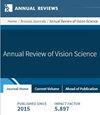Applications of Adaptive Optics Imaging for Studying Conditions Affecting the Fovea
IF 5
2区 医学
Q1 NEUROSCIENCES
引用次数: 0
Abstract
The fovea is a highly specialized region of the central retina, defined by an absence of inner retinal layers and the accompanying vasculature, an increased density of cone photoreceptors, a near absence of rod photoreceptors, and unique private-line photoreceptor to midget ganglion cell circuitry. These anatomical specializations support high-acuity vision in humans. While direct study of foveal shape and size is routinely performed using optical coherence tomography, examination of the other anatomical specializations of the fovea has only recently become possible using an array of adaptive optics (AO)-based imaging tools. These devices correct for the eye's monochromatic aberrations and permit cellular-resolution imaging of the living retina. In this article, we review the application of AO-based imaging techniques to conditions affecting the fovea, with an emphasis on how imaging has advanced our understanding of pathophysiology.自适应光学成像在研究影响眼窝条件方面的应用
眼窝是视网膜中央的一个高度特化区域,其特征是没有视网膜内层和伴随的血管,锥体感光细胞密度增加,几乎没有杆状感光细胞,以及独特的从感光细胞到侏儒神经节细胞的私线电路。这些解剖学上的特化为人类的高敏锐度视觉提供了支持。虽然对眼窝形状和大小的直接研究通常是通过光学相干断层扫描来进行的,但对眼窝其他解剖学分化的研究直到最近才有可能通过一系列基于自适应光学(AO)的成像工具来进行。这些设备可以校正眼睛的单色像差,并对活体视网膜进行细胞分辨率成像。在这篇文章中,我们回顾了基于自适应光学的成像技术在影响眼窝的病症中的应用,重点是成像如何促进了我们对病理生理学的理解。
本文章由计算机程序翻译,如有差异,请以英文原文为准。
求助全文
约1分钟内获得全文
求助全文
来源期刊

Annual Review of Vision Science
Medicine-Ophthalmology
CiteScore
11.10
自引率
1.70%
发文量
19
期刊介绍:
The Annual Review of Vision Science reviews progress in the visual sciences, a cross-cutting set of disciplines which intersect psychology, neuroscience, computer science, cell biology and genetics, and clinical medicine. The journal covers a broad range of topics and techniques, including optics, retina, central visual processing, visual perception, eye movements, visual development, vision models, computer vision, and the mechanisms of visual disease, dysfunction, and sight restoration. The study of vision is central to progress in many areas of science, and this new journal will explore and expose the connections that link it to biology, behavior, computation, engineering, and medicine.
 求助内容:
求助内容: 应助结果提醒方式:
应助结果提醒方式:


